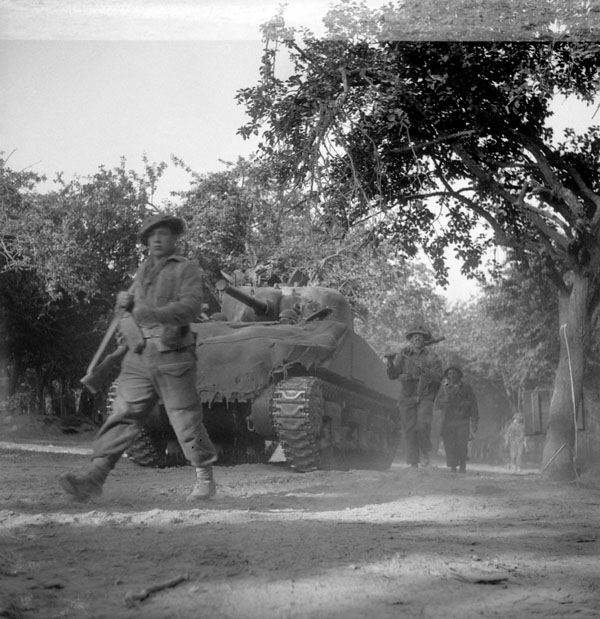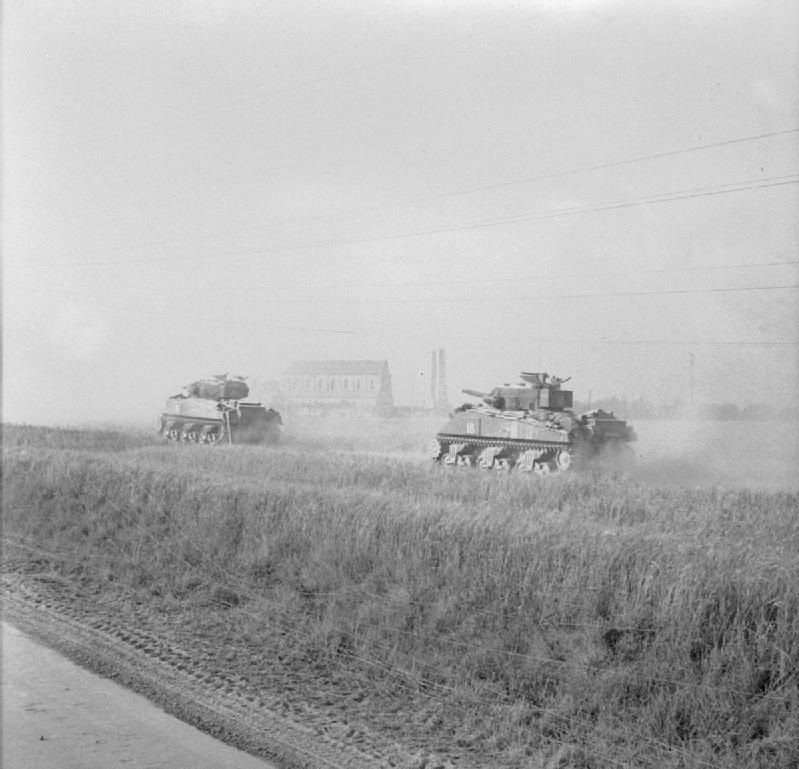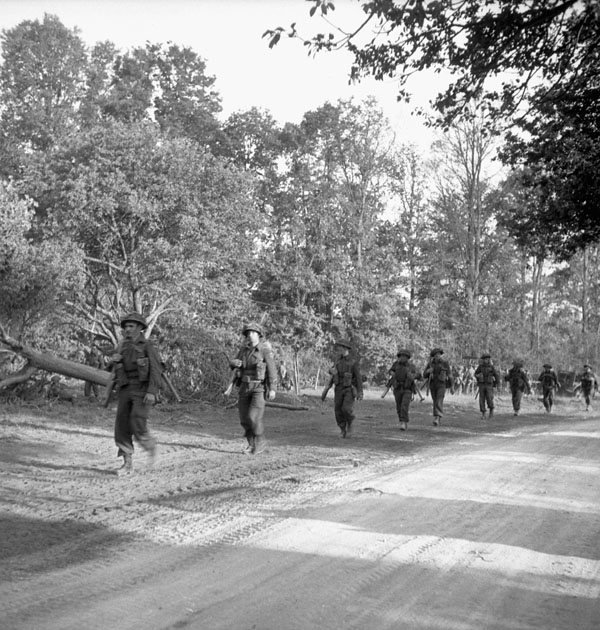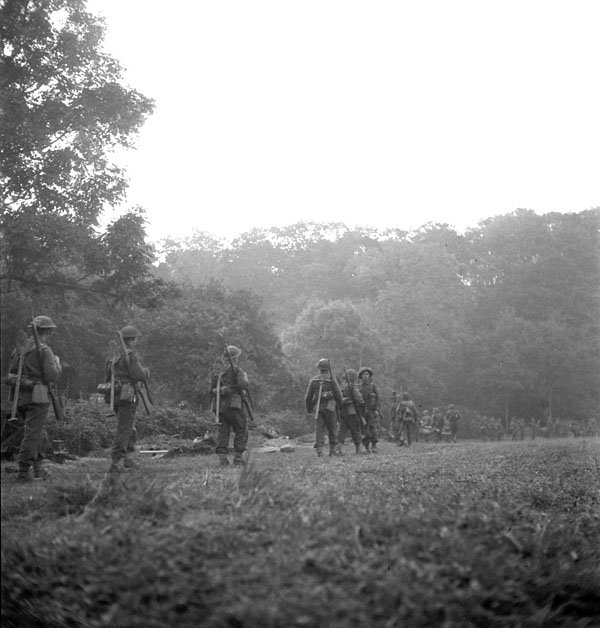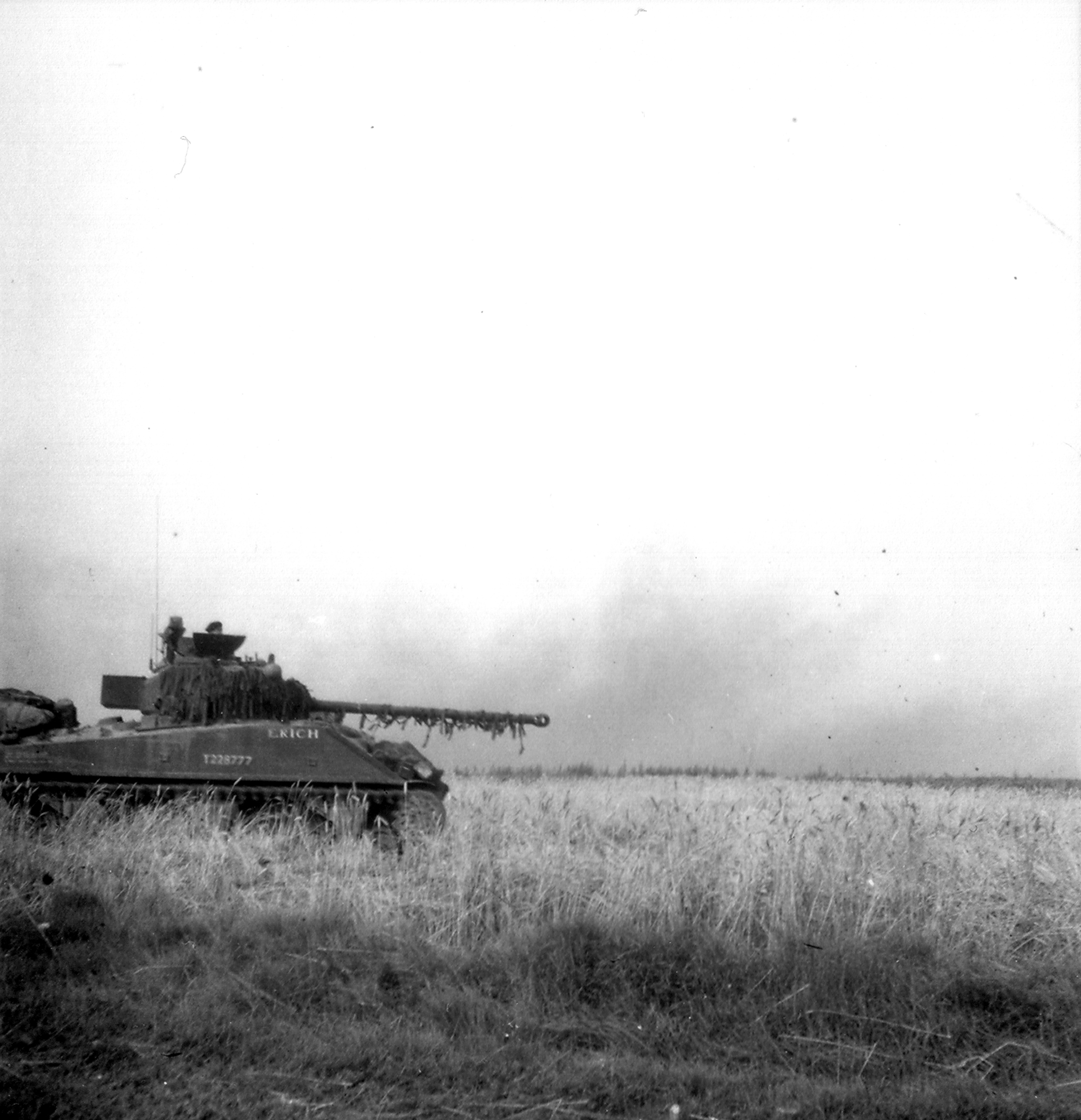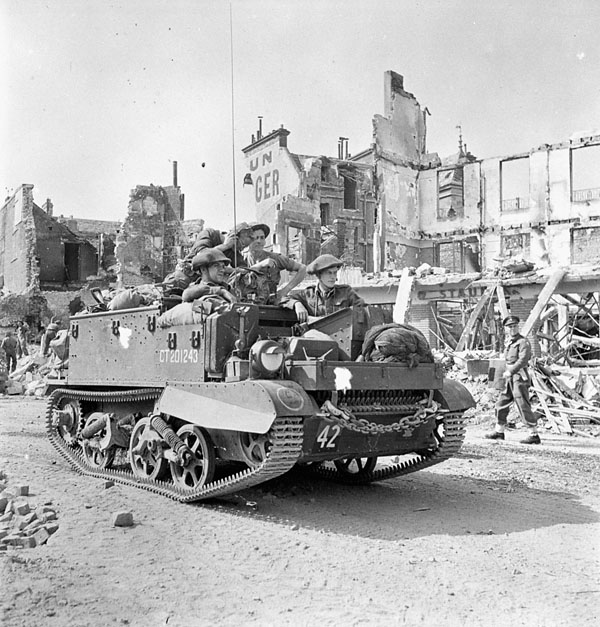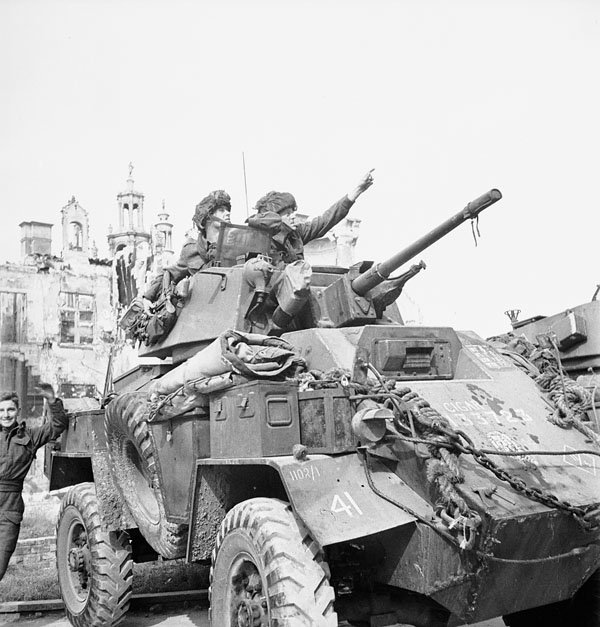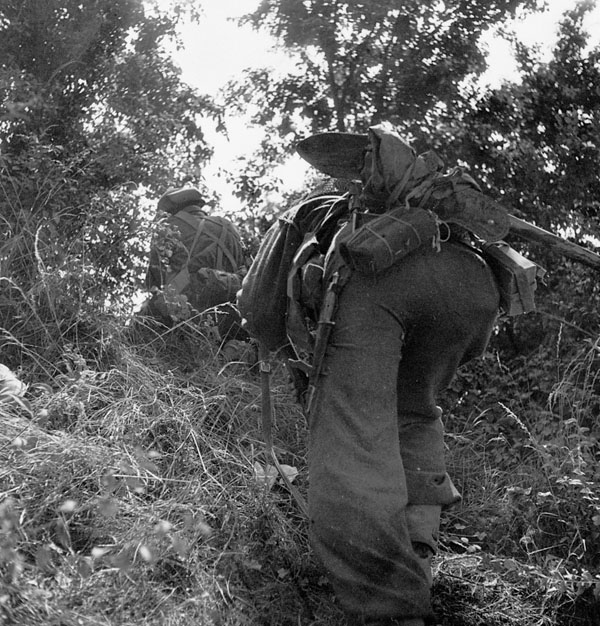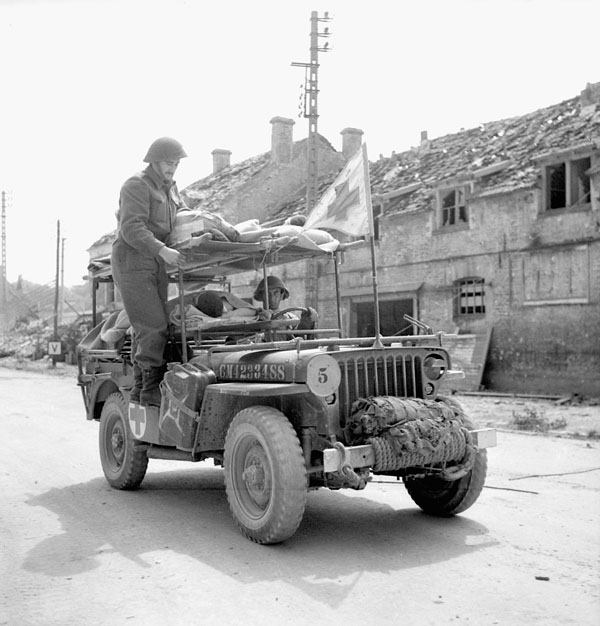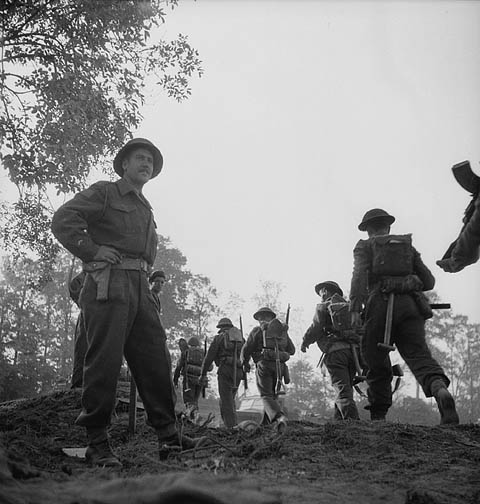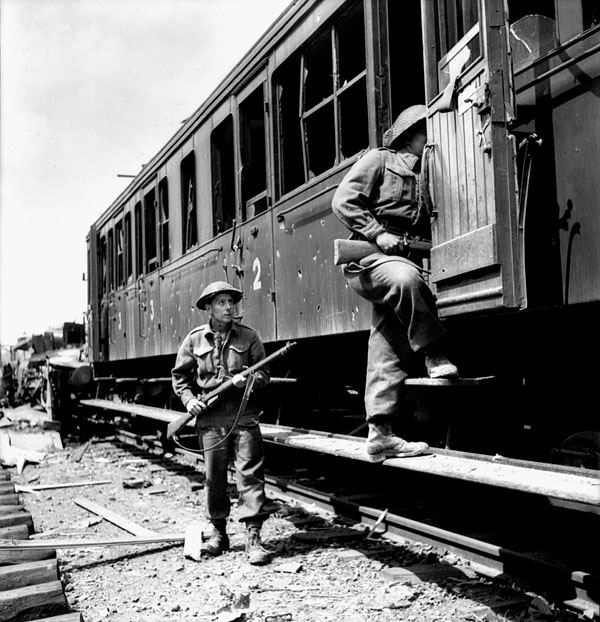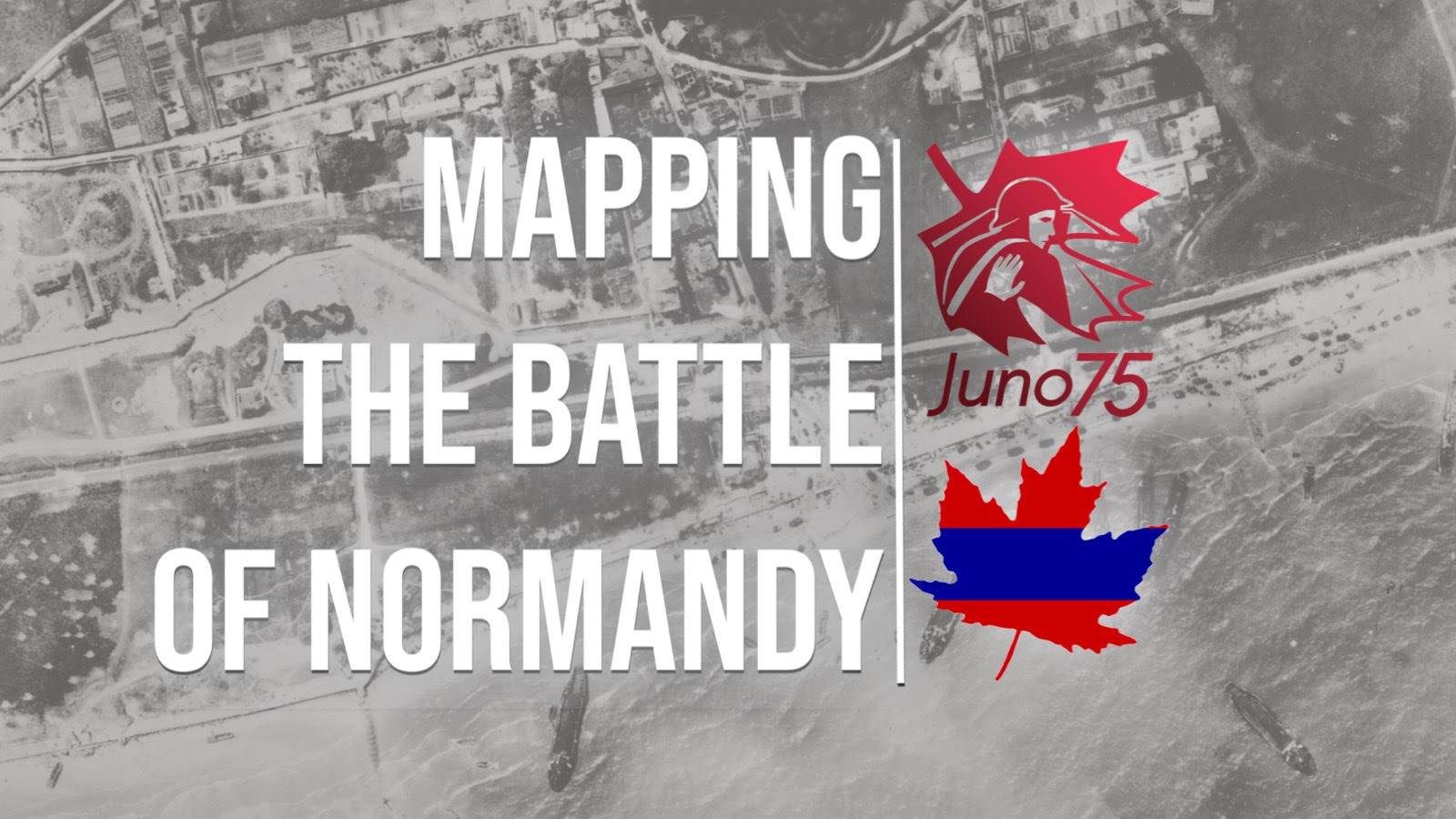Op Atlantic
by Alexander Fitzgerald-Black
Situation
Operation Atlantic, 18 to 21 July 1944. The debut of 2nd Canadian Infantry Division and II Canadian Corps headquarters in Normandy. Its purpose was to guard the western (right) flank of a British armoured assault (Operation Goodwood) to the east and south of Caen. Operations Goodwood and Atlantic were part of a series of costly battles designed to grind down the German armies in Normandy to facilitate a breakout.
CRMA/LAC/DND
Background
The Battle of Normandy had long been a battle of attrition. On 15 July 1944, Field Marshal Erwin Rommel wrote that his forces had taken 97,000 casualties and had received only 6,000 reinforcements. Likewise, the Germans had lost 250 tanks but had received a paltry 17 replacements. The German position in Normandy was close to a crisis.[1]
Joe Lapointe’s Panther. DND/LAC
Collection Rodger Hamilton: The War Photos
General Bernard Montgomery, the Allied ground force commander, intended for the German army to crack first. He approved a series of offensives designed to wear the Germans down. Hopefully, these attacks would buckle the German line enough for the Allies to break out of their bridgehead in Normandy.[2] In the centre, a British force would threaten German positions in the Odon River valley (Operations Greenline and Pomegranate, 15-17 July). In the west, Lieutenant General Omar Bradley would send the First US Army south from Saint-Lô (Operation Cobra, delayed until 25 July), through German lines pulverized by American heavy bombers, and into Brittany.
In the east, Lieutenant-General Miles Dempsey planned an ambitious operation that concentrated three British armoured divisions on a narrow 1-mile front (Operation Goodwood, 18 July). Dempsey tasked two Canadian infantry divisions (Operation Atlantic) and two British infantry divisions to support the flanks of the tank-heavy assault. This plan was in place on 12 July, but by 15 July General Montgomery had changed his tune. Believing a breakout at Caen unlikely, he changed his directive to focus on wearing down German formations. The plan, which included a provision for heavy bombers to strike the flanks of the advance, remained unchanged.[3]
The Battle
Defensive position overlay. CRMA/LAC/DND
Operation Atlantic opened with Canadian infantry and tanks crossing the Caen Canal and the Orne River northeast of the city. They pivoted and attacked south through a wooded area and into Colombelles, an industrial suburb filled with factories, slag heaps, and craters left by the preceding heavy bomber strikes.
The Queen’s Own Rifles of Canada made good progress. Along with a squadron of 1st Hussars tanks, they fought a successful all-day battle for Giberville. On 19 July their war diarist recorded, “the battle yesterday was rather expensive in that we suffered 76 casualties. However, as we took upwards of 600 prisoners, killed more than 200 and captured a great deal of his equipment, it certainly was not in vain.”[4]
Tank support was less available at Colombelles. The heavy cratering made it difficult for tanks to get forward to support Le Régiment de la Chaudière’s attack on the town’s château. The building fell after the Chauds followed a second artillery barrage onto the objective.
The barrage also caused casualties among the Stormont, Dundas, and Glengarry Highlanders. The Highlanders were frustrated as they tried to work forward to the industrial area. “The craters are proving a definite hindrance,” they reported. “We cannot deploy except to go into the river or up a cliff.”[5] The tight confines of the battlefield got them caught up in the Chaud’s battle.
Phase I concluded as The Regina Rifle Regiment crossed the Orne River at Caen and The North Nova Scotia Highlanders and The Highland Light Infantry of Canada pushed beyond Colombelles and into Vaucelles from the northeast. At the cost of 386 casualties (86 killed in action), the 3rd Canadian Infantry Division achieved all of its objectives.[6]
British Armoured Column. IWM
The British infantry did not fare as well. This left the eastern flank of the British armoured corps open. The tanks, having driven a 7-mile wedge into the German line, could go no further. Lieutenant-General Dempsey halted Operation Goodwood on 20 July, short of the Verrières-Bourgébus Ridge.
Phase II of Operation Atlantic called for Lieutenant-General Guy Simonds’s II Canadian Corps to push south from Vaucelles and to capture the western part of Verrières Ridge. But the situation had changed. Shutting down Goodwood meant that the attack on the ridge no longer needed to proceed. Simonds, however, believed that fresh infantry could take the ridge, which would offer an excellent position from which to launch future offensives south of Caen.
The infantry battalions of the 2nd Canadian Infantry Division had done good work in Phase I of Operation Atlantic. The Calgary Highlanders, who secured Point 67, south of Fleury-sur-Orne, believed ‘It can be safely said now, that for “green horners” in real live battle, we have proven our worth.’[7] The real test was forthcoming.
Destroyed/Captured Panzer IV. IWM
General Simonds ordered the division to advance up Verrières Ridge on 20 July. The attack began in the afternoon after the British had withdrawn their armoured forces from the eastern part of the ridge. It began to rain heavily, reducing visibility and limiting artillery and air support, two advantages that Allied armies in Normandy usually held. The conditions made life difficult for the poor bloody infantry in particular:
OLD SOLDIERS NEVER DIE - THEY DIG…
Slit trenches accumulated water, the fields became muddy and the task of keeping weapons in working order [became] almost impossible. The men worked continuously on their LMGs, even tearing off their shirts for rags in a futile attempt to keep them in order.[8]
As the forward battalions reached their objectives, German tanks and infantry began extensive counterattacks. Units like Les Fusiliers Mont-Royal and The Queen’s Own Cameron Highlanders of Canada managed to hold most of their newly won gains. Others like The South Saskatchewan Regiment and The Essex Scottish Regiment were thrown back. By 21 July there were elements of four German panzer divisions operating on the ridge. The Germans could not let this position fall. The high ground south of Caen was crucial to holding the line in Normandy.
Aftermath
Operation Atlantic ended with mixed results. The 3rd Canadian Infantry Division successfully captured the industrial areas and suburbs east and south of Caen while protecting the British armoured divisions’ western flank.
The 2nd Canadian Infantry Division’s first battle in Normandy started well but ended up as a near disaster. With hindsight, Lieutenant-General Simonds’s decision to send the unit’s infantry battalions up Verrières Ridge on 20 July was a mistake. More than half of 2nd Division’s casualties during Atlantic occurred on the last day.[9] Total Canadian casualties amounted to 1,614 killed, wounded, and missing.[10]
As Montgomery expected, Goodwood did not lead to a breakout. It had, however, landed another blow on the German army and pulled German armoured divisions into the Anglo-Canadian sector on the eve of Operation Cobra. The Germans were ripe for a collapse in Normandy. The question was whether the heavy casualties and declining morale of the Anglo-Canadian formations would get in the way of exploiting this hard-won advantage.[11]
[1] Terry Copp and Matt Baker, Canadian Battlefields of the Second World War: Dieppe, D-Day, & the Battle of Normandy (Waterloo, ON: LCMSDS Press of Wilfrid Laurier University, 2019), p.140.
[2] Terry Copp, Fields of Fire: The Canadians in Normandy (Toronto: University of Toronto Press, 2007), p.135.
[3] Jonathan Fennell, Fighting the People’s War: The British and Commonwealth Armies in the Second World War (Cambridge: Cambridge University Press, 2019), p.520.
[4] Library and Archives Canada (LAC), RG 24-C-3 Volumes 15168 and 15169, The Queen’s Own Rifles of Canada War Diary, 19 July 1944.
[5] LAC, RG 24-C-3 Volumes 15270 and 15271, The Stormont, Dundas and Glengarry Highlanders War Diary, 18 July 1944.
[6] Copp, Fields of Fire, p.140.
[7] LAC, RG 24-C-3 Volume 15020, The Calgary Highlanders War Diary, 19 July 1944.
[8] LAC, RG 24-C-3 Volume 15061, The Essex Scottish Regiment War Diary, 21 July 1944.
[9] Copp and Baker, p.139.
[10] Tim Cook, Fight to the Finish: Canadians in the Second World War, Volume Two (Toronto: Allen Lane, 2015), p.214.
[11] This argument is put forward by Terry Copp in Fields of Fire, p.153 and enhanced by Jonathan Fennell’s analysis of Goodwood in Fighting the People’s War, p.530.

